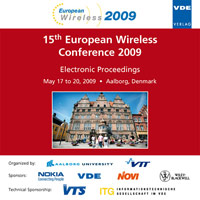Relaying in Long Term Evolution: Indoor Full Frequency Reuse
Konferenz: European Wireless 2009 - 15th European Wireless Conference
17.05.2009 - 20.05.2009 in Aalborg, Denmark
Tagungsband: European Wireless 2009
Seiten: 5Sprache: EnglischTyp: PDF
Persönliche VDE-Mitglieder erhalten auf diesen Artikel 10% Rabatt
Autoren:
Venkatkumar, V.; Wirth, T.; Haustein, T. (Fraunhofer Institute for Telecommunications, Heinrich-Hertz-Institut, Einsteinufer 37, 10587 Berlin, Germany)
Schulz, E. (Nokia Siemens Networks GmbH & Co.KG, St. Martinstraße 53, 81617 Munich, Germany)
Inhalt:
Future cellular wireless networks could include multihop transmissions through relays. For LTE-Advanced networks multihop relaying is one of the candidate enabling techniques for coverage extension. In particular, relaying is envisioned for indoor coverage, such as in office and residential buildings. In this approach, a wireless relay is placed inside a building in order to reduce the building penetration path loss. A relay could perform analog signal amplification or decode and forward operation. Decode and forward operation is advantageous in the sense that a relay can employ full reuse of the bandwidth. The re-used bandwidth could also be used efficiently by independent link adaptation. This paper reports measurement results of state of art direct link and indoor decode and forward relaying in LTE downlink. Relaying has been implemented in a real-time test-bed with enabling transceiver techniques such as half-duplex interference suppression and IP packet forwarding. The relay test-bed reuses the full 20 MHz bandwidth with frequency dependent link adaptation. Field trial measurements are performed in a single cell single user indoor office scenario with one relay. Results show that indoor LTE relaying is capable of delivering high throughput above 60 Mbps, with a spectral efficiency of 3 bits/s/Hz. It also provides 16 Mbps to locations well inside the building which is seen to be more dramatic.


